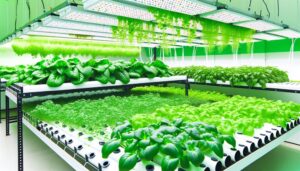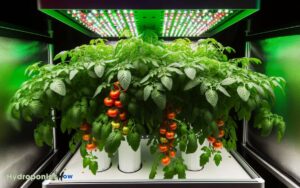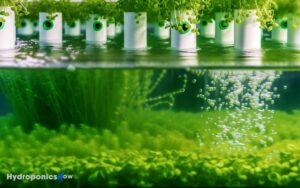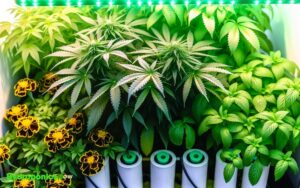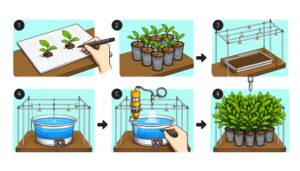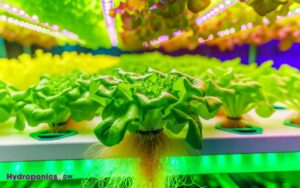10 Factors: How Long Will Hydroponic Tomato Plants Produce?
Hydroponic tomato plants, especially indeterminate varieties like ‘Trust’ or ‘Geronimo,’ can yield fruit continuously for 6 to 8 months under ideal conditions.
Maintain a light duration of 14-18 hours per day with intensity levels between 500-1,000 µmol/m²/s. Regularly adjust your nutrient solution, focusing on nitrogen during the vegetative phase and potassium/phosphorus during fruiting.
Disease-resistant varieties tagged ‘VFN’ and stringent hygiene protocols reduce crop losses by up to 30%. Use organic treatments such as neem oil and Bacillus subtilis for disease control.
Your plants’ productivity will depend on these critical factors for sustainability and extended harvests. Discover more below.
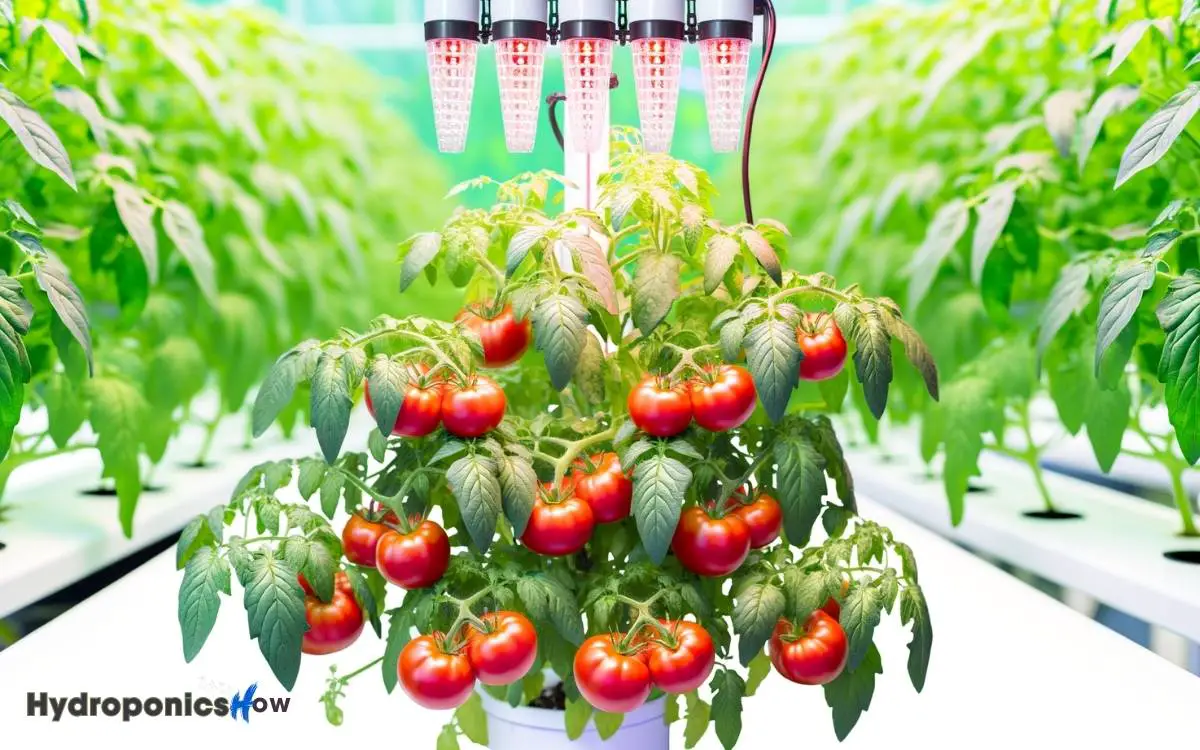
Key Takeaways
Tomato Varieties
When choosing tomato varieties for hydroponic production, you’ll need to take into account factors such as growth habit, fruit size, and disease resistance to optimize yield and quality.
Select indeterminate varieties like ‘Trust’ or ‘Geronimo’ for continuous fruiting. These varieties exhibit a vine-like growth habit, which is ideal for hydroponic systems.
Aim for medium-sized fruits, around 100-150 grams, to balance yield and handling efficiency.
Disease resistance is vital; opt for varieties resistant to common pathogens like Fusarium wilt and Powdery mildew. Look for varieties labeled with disease resistance codes (e.g., ‘VFN’ for Verticillium, Fusarium, and Nematodes).
Data shows that resistant varieties reduce crop losses by up to 30%, significantly impacting overall production efficiency and profitability.
Growth Phases
Understanding the distinct growth phases of hydroponic tomato plants—germination, vegetative, flowering, and fruiting is essential for optimizing nutrient delivery and environmental conditions. During germination, seeds require high humidity and consistent moisture. As the plants transition to the vegetative stage, they need ample light, balanced nutrients, and proper oxygenation to develop strong roots and healthy foliage. When growers grow tomato plants hydroponically, they must adjust nutrient concentrations and maintain ideal temperature and humidity levels to support each stage. Proper management during flowering and fruiting ensures optimal yields and high-quality tomatoes.
Moving into the vegetative phase, plants demand increased nitrogen for robust leaf and stem development. The flowering phase calls for a balanced nutrient mix to support bud formation and pollination.
Finally, the fruiting phase focuses on potassium and phosphorus to promote fruit set and development.
- Germination: High humidity, consistent moisture
- Vegetative: Increased nitrogen, vigorous leaf growth
- Flowering: Balanced nutrients, bud formation
- Fruiting: Potassium, phosphorus, fruit set
- Environmental Conditions: Temperature, humidity control
Light Requirements
To achieve peak growth for hydroponic tomato plants, you must guarantee a light duration of 14-18 hours per day.
Data indicates that maintaining light intensity levels between 500-1,000 µmol/m²/s is essential for maximizing photosynthesis.
When comparing artificial and natural light sources, studies show that LED grow lights can provide consistent, controllable conditions that often outperform natural light in indoor setups.
Optimal Light Duration
For essential growth in hydroponic tomato plants, providing 14-18 hours of high-intensity light daily is ideal to maximize photosynthesis and fruit production.
Securing this ideal light duration impacts several growth parameters:
- Photosynthetic Efficiency: Extended light exposure enhances the plant’s ability to convert light into chemical energy.
- Flowering and Fruiting: Consistent light periods promote timely flowering and robust fruit development.
- Inter-nodal Spacing: Proper light duration minimizes excessive elongation, resulting in sturdier plants.
- Nutrient Uptake: Adequate light boosts the plant’s nutrient absorption rates, leading to healthier growth.
- Overall Yield: Maximizing light exposure correlates with increased fruit yield and quality.
Adhering to the 14-18 hour light schedule secures that your hydroponic tomatoes achieve their full productive potential.
Light Intensity Levels
Maintaining an essential light intensity of 400-700 µmol/m²/s is vital for maximizing the photosynthetic capacity of hydroponic tomato plants.
You should monitor this range meticulously, as it directly influences the rate of photosynthesis, plant growth, and fruit production.
Exceeding 700 µmol/m²/s can lead to photoinhibition, where light intensity damages the plant’s photosynthetic apparatus. Conversely, levels below 400 µmol/m²/s may not sufficiently energize photosynthesis, stunting growth.
Utilize a quantum sensor to measure photosynthetic photon flux density (PPFD) accurately. Ensure even light distribution to avoid shading and hotspots.
Artificial Vs. Natural Light
Choosing between artificial and natural light for hydroponic tomato plants involves understanding their distinct impacts on growth parameters.
Artificial light provides control over light intensity and duration, ensuring ideal photosynthetic activity. It offers uniformity but often comes with higher operational costs due to electricity consumption.
On the other hand, natural sunlight is free and offers a full spectrum, but its availability varies seasonally and geographically, affecting growth consistency.
- Energy Efficiency: Artificial lights like LEDs are energy-efficient but costly.
- Consistency: Artificial light offers uniformity, whereas natural light fluctuates.
- Spectrum Quality: Sunlight provides a complete spectrum; artificial lights can be tailored.
- Operational Costs: Natural light is free; artificial lighting incurs costs.
- Control: Artificial light allows precise control over growth cycles.
Nutrient Management
Effective nutrient management is crucial for maximizing the growth and yield of hydroponic tomato plants, requiring precise monitoring of nutrient solution composition, pH levels, and electrical conductivity.
You should regularly test and adjust these parameters to guarantee the best nutrient availability. Here’s a guide:
| Parameter | Ideal Range | Monitoring Frequency |
|---|---|---|
| Nitrogen (N) | 150-250 ppm | Weekly |
| Phosphorus (P) | 40-60 ppm | Weekly |
| Potassium (K) | 200-300 ppm | Weekly |
| pH Level | 5.5-6.5 | Daily |
| Electrical Conductivity | 1.5-3.0 mS/cm | Daily |
Maintaining these parameters ensures your plants receive the right nutrients, preventing deficiencies and toxicities. Utilize calibrated equipment for accuracy and make incremental adjustments to avoid shocking your plants.
This approach maximizes productivity and extends the productive lifespan of your hydroponic tomato plant.
Disease Control
To maintain peak tomato plant health in a hydroponic system, you must address common diseases such as Fusarium wilt and powdery mildew through rigorous prevention and hygiene protocols.
Data shows that maintaining a sterile environment can reduce disease incidence by up to 60%. Consider incorporating organic treatment methods like neem oil and beneficial microbes to further enhance disease resistance.
Common Tomato Diseases
Identifying and managing common tomato diseases in hydroponic systems requires an understanding of specific pathogens, such as Fusarium wilt and powdery mildew, along with their environmental triggers and effective treatment protocols.
Fusarium wilt thrives in warm temperatures and high humidity, causing vascular discoloration and plant wilting. Powdery mildew manifests as a white powdery substance on leaves, exacerbated by poor air circulation.
To mitigate these issues, you should:
- Monitor nutrient solution pH levels: Maintain pH within the range of 5.5 and 6.5 to inhibit pathogen growth.
- Regulate temperature and humidity: Keep levels at an appropriate range to prevent disease proliferation.
- Implement biological controls: Utilize beneficial microbes to combat pathogens.
- Apply fungicides: Use them judiciously following label instructions.
- Inspect plants regularly: Early detection allows for prompt treatment.
These steps help maintain plant health and productivity.
Prevention and Hygiene
Maintaining stringent hygiene protocols and preventive measures in your hydroponic system is crucial for minimizing the risk of disease outbreaks. Start by sterilizing all equipment before introducing plants.
Regularly clean and disinfect reservoirs, trays, and tools using a 10% bleach solution. Implement a strict schedule for inspecting plants for early signs of disease, such as discoloration or wilting.
Guarantee proper air circulation by spacing plants appropriately and using fans, which reduces humidity and fungal growth. Monitor water quality and nutrient levels meticulously; imbalances can stress plants, making them susceptible to pathogens.
Replace nutrient solutions every two weeks to prevent microbial buildup. Employing these practices reduces disease incidence, thereby extending the productive lifespan of your hydroponic tomato plants.
Organic Treatment Methods
Employing organic treatment methods for disease control in hydroponic tomato production guarantees efficient management of pathogens without resorting to synthetic chemicals. You’ll enhance plant health by utilizing biologically-based interventions.
Consider the following organic methodologies:
- Neem Oil: Acts as a broad-spectrum biopesticide, disrupting pest life cycles.
- Bacillus subtilis: A beneficial bacterium that competes with pathogenic microbes, reducing disease incidence.
- Companion Plants: Plants like basil can deter pests and bolster tomato plant resilience.
- Trichoderma: A fungus that colonizes root systems, offering protection against soil-borne diseases.
- Compost Tea: Enhances microbial diversity and suppresses harmful pathogens through competitive exclusion.
These strategies provide a sustainable approach, ensuring long-term crop strength and reducing reliance on harmful chemicals.
Implementing such methods will foster a healthier, more productive hydroponic system.
Harvesting Cycle
The harvesting cycle for hydroponic tomato plants typically spans 60 to 85 days from transplanting, depending on the tomato variety and growing conditions.
You’ll observe that indeterminate varieties continuously produce fruit, extending the harvesting window. Ideal light exposure, nutrient balance, and temperature control play vital roles in maximizing yield.
Tomatoes are ready for harvest when they reach full color and firmness. Use a refractometer to measure Brix levels, ensuring peak sweetness and flavor. Pruning and regular monitoring for pests and diseases help maintain plant health.
Keep track of each plant’s performance using data logs to fine-tune your growing techniques. Consistent harvesting every 2-3 days can prevent overripening and guarantee a steady supply of fresh tomatoes.
Conclusion
In hydroponics, your tomato plants can produce fruit for up to 11 months with ideal conditions. By maintaining precise nutrient levels, consistent light exposure of 14-18 hours per day, and vigilant disease control, you’ll maximize yields.
Surprisingly, hydroponic tomatoes often yield up to 30% more fruit compared to soil-grown counterparts. This impressive increase highlights the efficiency of hydroponic systems in controlled environments, ensuring you get the most out of every growth cycle.

